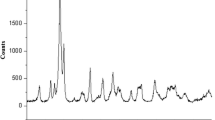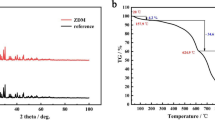Abstract
Nanoporous carbons which possess high surface areas and narrow pore size distributions have become one of the most important classes of porous materials with potential to be utilized for hydrogen storage. In recent times, several metal–organic frameworks (MOFs) have been shown to be promising precursors for creating nanoporous carbons due to their high surface areas and tunable pore sizes. The pore structure and surface area of the resultant carbon materials can be tuned simply by changing the calcination temperature. In this work, a zinc-based MOF (MOF-5) and a chromium-based MOF (Cr-MOF) were both used as precursors for syntheses of nanoporous carbons by the direct carbonization technique at different temperatures. The resultant carbon nanostructure from MOF-5 possessed higher surface area, higher pore volume and enhanced hydrogen storage capacity as compared to pristine MOF. Meanwhile, the derived carbons from Cr-MOF displayed lower surface areas, pore volumes and hydrogen uptake than the parent MOF due to the formation of chromium oxide and carbide species in the pores of the Cr-MOF-derived carbons.





Similar content being viewed by others
References
G. Sandrock, A panoramic overview of hydrogen storage alloys from a gas reaction point of view. J. Alloys Compd. 293, 877–888 (1999)
L. Schlapbach, Technology, hydrogen-fuelled vehicles. Nature 460, 809–811 (2009)
O.M. Yaghi, M. O’Keeffe, N.W. Ockwig, H.K. Chae, M. Eddaoudi, J. Kim, Reticular synthesis and the design of new materials. Nature 423, 705–714 (2003)
N.L. Rosi, J. Eckert, M. Eddaoudi, D.T. Vodak, J. Kim, M. O’Keeffe et al., Hydrogen storage in microporous metal-organic frameworks. Science 300, 1127–1129 (2003)
H. Furukawa, K.E. Cordova, M. O’Keeffe, O.M. Yaghi, The chemistry and applications of metal-organic frameworks. Science 341, 1230444 (2013)
N. Takeichi, H. Senoh, T. Yokota, H. Tsuruta, K. Hamada, H.T. Takeshita et al., “Hybrid hydrogen storage vessel”, a novel high-pressure hydrogen storage vessel combined with hydrogen storage material. Int. J. Hydrog. Energy 28, 1121–1129 (2003)
S.J. Yang, T. Kim, J.H. Im, Y.S. Kim, K. Lee, H. Jung et al., MOF-derived hierarchically porous carbon with exceptional porosity and hydrogen storage capacity. Chem. Mater. Mater. 24, 464–470 (2012)
H. Reardon, J.M. Hanlon, R.W. Hughes, A. Godula-Jopek, T.K. Mandal, D.H. Gregory, Emerging concepts in solid-state hydrogen storage: the role of nanomaterials design. Energy Environ. Sci. 5, 5951–5979 (2012)
M. Rose, B. Böhringer, M. Jolly, R. Fischer, S. Kaskel, MOF processing by electrospinning for functional textiles. Adv. Eng. Mater. 13, 356–360 (2011)
T. Tsuruoka, S. Furukawa, Y. Takashima, K. Yoshida, S. Isoda, S. Kitagawa, Nanoporous nanorods fabricated by coordination modulation and oriented attachment growth. Angew. Chem. Int. Ed. 48, 4739–4743 (2009)
Q. Yang, W. Xu, A. Tomita, T. Kyotani, The template synthesis of double coaxial carbon nanotubes with nitrogen-doped and boron-doped multiwalls. J. Am. Chem. Soc. 127, 8956–8957 (2005)
J. Tang, R.R. Salunkhe, J. Liu, N.L. Torad, M. Imura, S. Furukawa et al., Thermal conversion of core-shell metal–organic frameworks: a new method for selectively functionalized nanoporous hybrid carbon. J. Am. Chem. Soc. 137, 1572–1580 (2015)
V. Malgras, Q. Ji, Y. Kamachi, T. Mori, F. Shieh, K.C. Wu et al., Templated synthesis for nanoarchitectured porous materials. Bull. Chem. Soc. Jpn 88, 1171–1200 (2015)
C. Journet, W. Maser, P. Bernier, A. Loiseau, M.L. de La Chapelle, D.L.S. Lefrant et al., Large-scale production of single-walled carbon nanotubes by the electric-arc technique. Nature 388, 756–758 (1997)
B. Zheng, C. Lu, G. Gu, A. Makarovski, G. Finkelstein, J. Liu, Efficient CVD growth of single-walled carbon nanotubes on surfaces using carbon monoxide precursor. Nano Lett. 2, 895–898 (2002)
A. Ahmadpour, D. Do, The preparation of active carbons from coal by chemical and physical activation. Carbon 34, 471–479 (1996)
B. Liu, H. Shioyama, T. Akita, Q. Xu, Metal-organic framework as a template for porous carbon synthesis. J. Am. Chem. Soc. 130, 5390–5391 (2008)
J. Ren, D.E. Rogers, T. Segakweng, H.W. Langmi, B.C. North, M. Mathe et al., Thermal treatment induced transition from Zn3(OH)2 (BDC)2 (MOF-69c) to Zn4O(BDC)3 (MOF-5). Int. J. Mat. Res. 105, 89–93 (2014)
J. Ren, N.M. Musyoka, H.W. Langmi, T. Segakweng, B.C. North, M. Mathe et al., Modulated synthesis of chromium-based metal-organic framework (MIL-101) with enhanced hydrogen uptake. Int. J. Hydrog. Energy 39, 12018–12023 (2014)
M. Hu, J. Reboul, S. Furukawa, N.L. Torad, Q. Ji, P. Srinivasu et al., Direct carbonization of Al-based porous coordination polymer for synthesis of nanoporous carbon. J. Am. Chem. Soc. 134, 2864–2867 (2012)
T. Düeren, F. Millange, G. Férey, K.S. Walton, R.Q. Snurr, Calculating geometric surface areas as a characterization tool for metal-organic frameworks. J. Phys. Chem. 111, 15350–15356 (2007)
Acknowledgments
The financial support from the South African Department of Science and Technology (DST) towards HySA Infrastructure KP4 (grant no.: HTC004X) is gratefully acknowledged.
Author information
Authors and Affiliations
Corresponding authors
Rights and permissions
About this article
Cite this article
Segakweng, T., Musyoka, N.M., Ren, J. et al. Comparison of MOF-5- and Cr-MOF-derived carbons for hydrogen storage application. Res Chem Intermed 42, 4951–4961 (2016). https://doi.org/10.1007/s11164-015-2338-1
Received:
Accepted:
Published:
Issue Date:
DOI: https://doi.org/10.1007/s11164-015-2338-1




